E-commerce always surprises us. There’s something interesting popping up every now and then that catches our attention and hook us towards it. The spirit of such innovative ideas is what keeps the eCommerce business going which we are continuing to know more about it.
Tag: multi vendor marketplace

Multi-Vendor Marketplace – Benefits and Challenges
When you think of online marketplaces, Amazon, Etsy, and Alibaba are probably the first few names that come to mind. Interestingly, an increasing number of eCommerce hopefuls today are opting for the multi-vendor eCommerce marketplace model.
In essence, the said model is an online umbrella platform where each seller can run their shop autonomously on a single platform, while the platform owner takes care of different aspects of an eCommerce store such as order processing, tracking, and payments.
According to research, marketplaces will account for almost thrice as compared to single eCommerce stores by 2021.
The time is not far, and we can already see that the market is an efficient and popular business model for start-ups looking to cater to a global market.
Adding to that, let us take a look at the benefits of multi-vendor eCommerce marketplaces:
- More products and hence more customers
A multi-vendor eCommerce marketplace typically plays host to a wide variety of sellers who sell different types of items. Customers thus have the convenience of shopping for different kinds of goods under one roof.
This attracts a more significant number of customers than if the marketplace were to sell only one type of good. At the same time, vendors are attracted to the multi-vendor eCommerce marketplace model as it provides them with a convenient online setup and a vast pool of customers to sell to.
For both these reasons, a marketplace model is a lucrative option for an eCommerce business to consider.
- No need to maintain inventory
An eCommerce start-up will likely not be able to afford the costs of maintaining a full warehouse of sellable goods. In a multi-vendor marketplace, however, each vendor is responsible for keeping his or her inventory.
That releases the start-up of considerable financial burden, which is significant in the initial stages, and they can focus instead on website improvements and on scaling up their business with focus and efficiency.
- Lower operation costs
When opening a multi-vendor marketplace, there is no need to invest time and money in designing products, maintaining inventories, or managing logistics. All of those are the responsibility of the sellers operating in the marketplace.
The marketplace can thus focus on promoting their business through social media, scaling its operations to reach global customers and website maintenance. This also means that they can work with a smaller team, which further brings down costs.
When it comes to creating virtual storefronts, the marketplace can do so easily with the help of any leading multi-vendor eCommerce marketplace software provider such as MobiCommerce. The company can help in launching a feature-rich, responsive online marketplace promptly.
- Easier to make money
Because of the wide variety of products and a large number of customers, marketplaces can make considerable sales far sooner than if they were to specialize in just one type of good. They earn a commission on each sale made by each vendor, the percentage for which they are free to decide.
The higher the number of sellers, the higher the volume of sales, and thus the higher the commission income for the marketplace.
However, a multi-vendor eCommerce platform comes with its own set of operational challenges, including:
- Price competition
While a large number of sellers ensure a wide variety of options for the buyers, it also leads to substantial price competition as there are several substitutes for each product. This could lead to intense price competition among vendors to grab larger market shares. As a result, the commission that the marketplace earns on each sale goes down.
- Quality maintenance
Different sellers offer products of varying quality levels, and the sheer number of sellers makes it impossible for the marketplace owner to do a quality check on every product. If there are too many vendors selling shoddy products, it could bring down the marketplace’s reputation in the eyes of the customers.
However, the problem can be addressed to some extent by having in place a customer rating system for each seller and removing the sellers whose ratings dip below a threshold level. Amazon has that option, wherein you can check the rating of the product and its seller right on the product page.
- Delivery management
While the vendors are responsible for the quality of their goods, the marketplace still needs to take care of deliveries. This requires efficient logistics in place to transport items safely and deliver them on time. Mainly, if the marketplace caters to multiple states or countries, managing these logistics can be a time-consuming and a rather expensive task.
The problem can be eliminated with a dynamic e storefront that allows the marketplace owner to track all deliveries from all sellers under a single roof.
- Customer management
Customer complaints are typically shared with the marketplace and not with the individual vendor. The marketplace is thus responsible for looking into the issues and following up on any refunds, returns, or replacements that might be needed.
That is a time-consuming process and requires a separate customer service team. Moreover, since complaints could come in 24×7, the marketplace needs to devote even more resources towards addressing all complaints promptly. However, this too can be resolved with the help of a marketplace solution provider.
Recommended Blog The B2B eCommerce Marketplace Technology
Wrapping up
A multi-vendor eCommerce platform requires superior technology and considerable investment to start the business on the right note. That is also one reason why many entrepreneurs shy away from dipping into the marketplace pond.
Thankfully, MobiCommerce is a multi-vendor eCommerce marketplace solution that can help them do away with such limitations and can figure out excellent growth opportunities without making a lot of mistakes.
So, what are you waiting for? Jump onto the marketplace at the earliest and thrive!
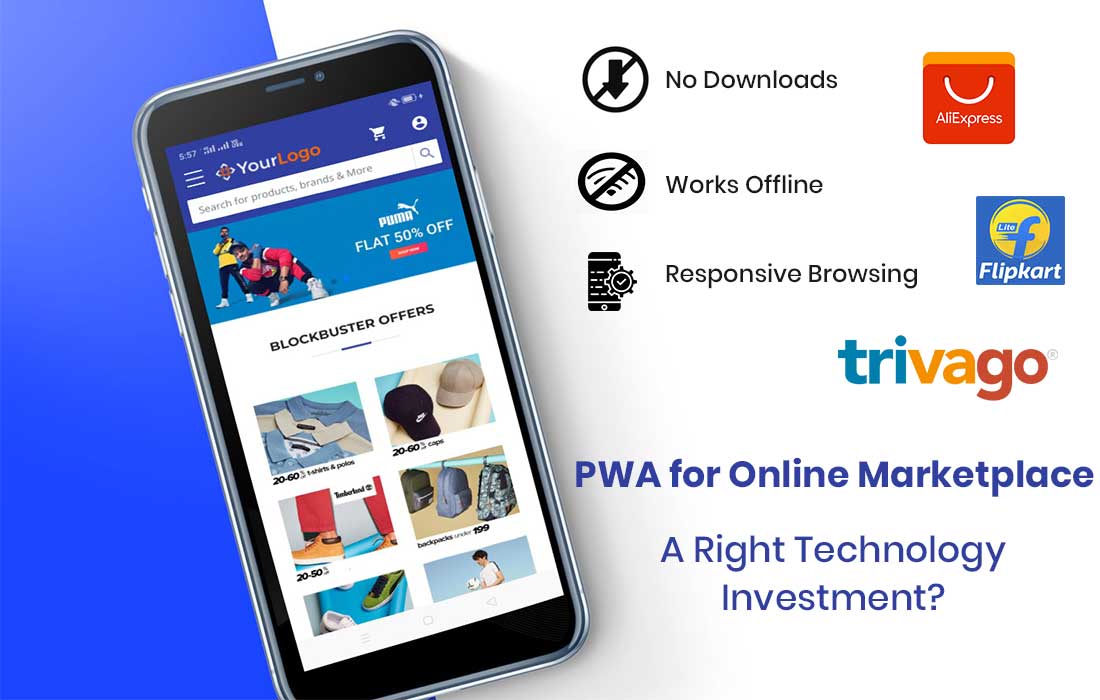
PWA for Online Marketplace: A Right Technology Investment?
Experimenting with new technology for an online marketplace can be scary, but should you be afraid of PWA?
Progressive Web App is the talk of the town, and the praises for its benefits have no end, yet, when it comes to investing in it, the cloud of suspicion forms in our head and gets stuck at one and the same point, “whether to invest or not?”
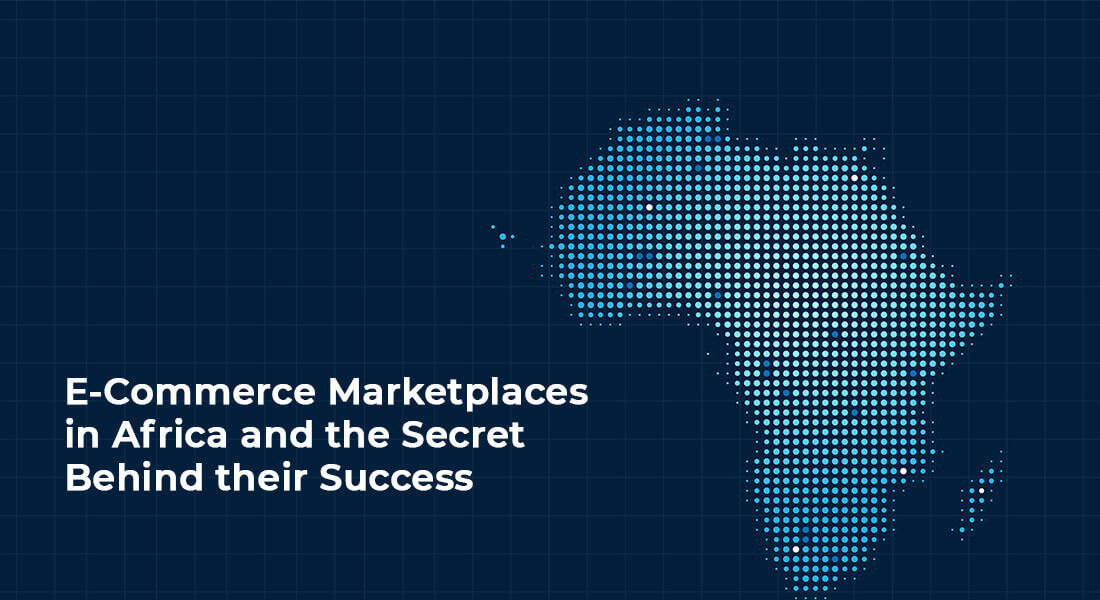
E-Commerce Marketplaces in Africa and the Secret Behind their Success
A large continent with as many as 54 countries, business in Africa, is a tough nut to crack. But then, what’s a business without challenges, right? Africa with its fast-growing population and markets is becoming a hot and important opportunity for businesses which a lot of eCommerce store owners are grabbing it now.
Africa has outstanding potential as a growth market for business which is underestimated and misunderstood often a bit due to lack of infrastructure, illiteracy, poverty etc. But a lot of eCommerce marketplaces are taking up it as a challenge and are bringing about the transformation which seemed impossible earlier.
African eCommerce Statistics
Countries like South Africa, Nigeria, Kenya, Morocco, Senegal, Ghana all have large domestic marketplaces today which are growing fast incredibly well. The 2018 United Nations Conference on Trade and Development (UNCTAD) B2C E-commerce Index which measures an economy’s preparedness to support online shopping based on four indicators: bank or mobile money account penetration, internet usage, availability of internet servers and the reliability of postal services ranked 151 countries globally, including 44 African nations. The results of which were as such;
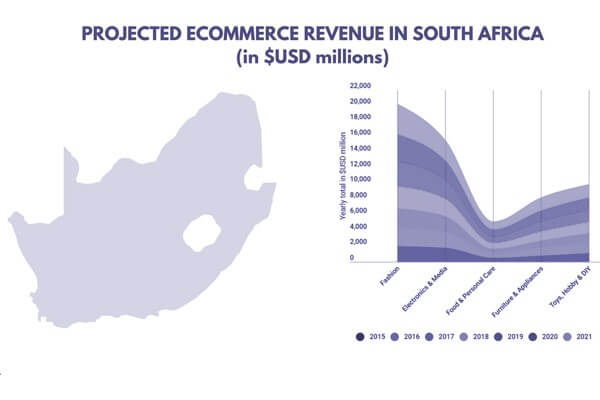
(Image Source: Statista, eCommerce South Africa)
- Mauritius top-ranked the index and has the second highest proportion of shoppers on the continent.
- Libya, ranked 13th in Africa for e-commerce readiness, having the highest proportion of online shoppers on the continent among people aged 15 and older.
- Nigeria, South Africa and Kenya estimated for nearly half of Africa’s estimated 21 million online shoppers.
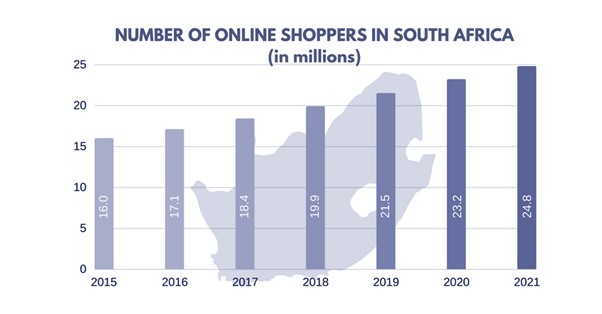
(Image Source: Statista, eCommerce South Africa, User in millions)
Since 2014, overall, the number of online shoppers across the continent has grown around 18% which is higher than the global average. Africa’s consumer e-commerce market valued at $5.7 billion in 2017 is less than 0.5% of the continent’s GDP, far below the global average of 4%.
eCommerce Craze in Countries
In Nigeria, with a population of 195 million people, has the most ecommerce sites and 40% of Africa’s ecommerce ventures have headquarters in Nigeria. It has an internet penetration of 70% and 26% of the population were recorded to have bought something online via phone in the past month as of 3rd quarter 2017.
South Africa on the other hand with a population of 57.4 million and 65% internet penetration, recorded 18% of mobile shoppers in the past month as of 3rd quarter 2017. South Africans are found to spend mostly in the fast food category of online shopping, while groceries are still purchased in-store than online.
Kenya with a population of 51 million and an impressive 82.6% internet penetration is home to M-Pesa, the mobile wallet provider started by mobile telecom provider Safaricom. More than 45% of Kenyan adults use M-Pesa according to Emergent Payments. 85% of Kenyans have adopted electronic means of payment, including bank accounts, mobile phone prepaid cards or other payment products. You won’t believe, about 75.5 % of mobile shoppers were recorded in the past month as of 3rd quarter 2017 in Kenya.
Ghana, having a population of 29.46 million and internet penetration of 45%, has taken eCommerce so seriously that it has a website dedicated specifically to ecommerce for SMEs.
Growth of Local eCommerce Platforms
Although Amazon, the eCommerce giant, showed no interest in the African market, a lot of local eCommerce platforms have emerged in the past few years to such extent that about 90% of investment is going those eCommerce start-ups in five African countries. One among such that has gained the limelight is Jumia.
“Jumia” – the Amazon of Africa:

(Image Reference: https://www.jumia.com.ng/)
A Nigeria-based group, Jumia which was founded in 2012 by the Berlin-based Rocket Internet, is Africa’s best-funded ecommerce start-up with more than 3,000 employees. It operates in 14 countries in Africa and the Middle East, with each country having its own site.
Jumia has solved the logistics barrier in Africa to a great extent with more than 500 motorbikes and trucks delivering their online products to customers in the country’s eight largest cities. Jumia accepts COD, which, again, is the preferred payment method for most Africans and has raised $150 million in 2014 alone.
“Konga.com”
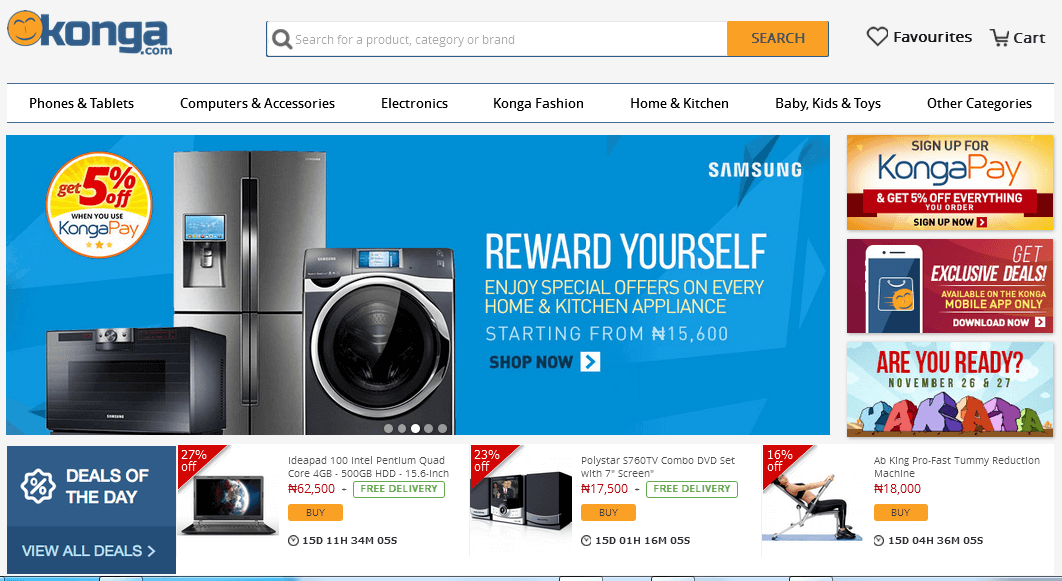
Konga.com, founded in 2012 in Nigeria that does not operate outside of Nigeria, opened Seller HQ, a third-party marketplace in 2014, now has about 1 million customers and receives over 300,000 unique visits daily. Its own logistics network — KOS Deliveries has a fleet of over 200 vehicles (vans, trucks, and motorbikes) and pick-up points and distribution centres in every part of Nigeria.
Konga even has its own payment system — KongaPay — that works with all banks in Nigeria. In 2018, Konga was acquired by a local hardware and information-technology services company, Zinox.
Success Secrets
- The African population is fast growing and urbanizing. It may reach 1.7 billion by 2030.
- Africa is witnessing an industrial revolution.
- The infrastructure gap is nearing closure. Africa’s annual investment in infrastructure has doubled to around $80 billion a year which represents a big opportunity for investors and entrepreneurs.
- New broadband connections and mobile data traffic are increasing which shows a good scope for mCommerce.
For an eCommerce marketplace to be a success in Africa is not as easy as other continents but is not impossible either. With a well-developed multi-vendor marketplace software, your strategies and market study, you can figure out excellent growth opportunities in Africa.
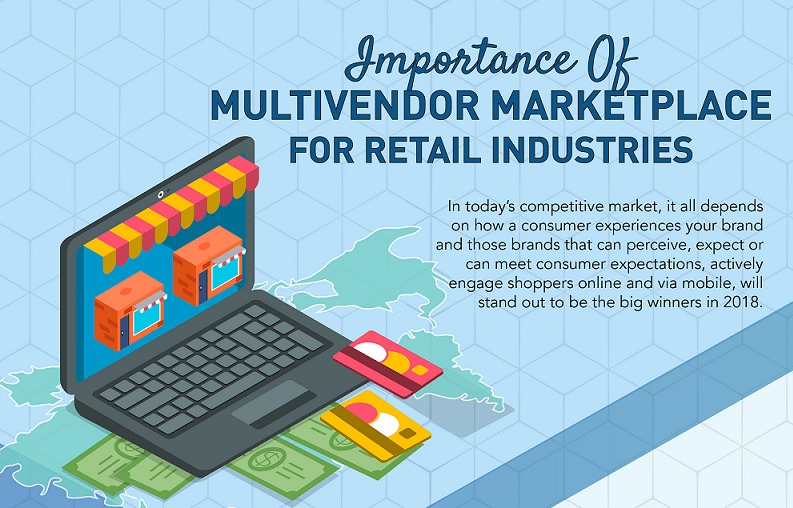
Infographic – Importance of Multivendor Marketplace for Retail Industries
A lot of changes have occurred in the eCommerce industry since its origin. Ecommerce nowadays has taken a faster pace. Selling own products solely to offering products from multiple-sellers is a trend e-commerce/business owners are adopting. Online stores are taking a quick shift towards Marketplaces.
Reasons of E-commerce shift to Marketplace
-
- In 2016, Amazon generated 22.99 billion U.S. dollars in third-party seller service revenues, up from 16.09 billion U.S. dollars in the previous year. Seller-service revenues account for the second-largest revenue segment of the online retail platform.
- Customer Retention: In comparison to single ecommerce stores, a multi-vendor marketplace helps in retaining up to 89% of the customers.
- Revenue Boost: Sales through Multivendor marketplaces will account to almost thrice as compared to online stores by 2021.
- Huge Traffic: Multi-vendor stores helps in grabbing more traffic in comparison to single online store.
- High Conversion Rates: Multi-vendor marketplaces offer a variety of products so that your customers need not look in to the other stores thereby increase in loyal customers and high conversion rates.
- Earn High Commissions: More varieties, more offerings, more sales, therefore more commissions in your pockets.
Take a sneak peek to the Custom Writing’s Infographic below to know the Importance of Multi-vendor Marketplace for Retail Industries.








